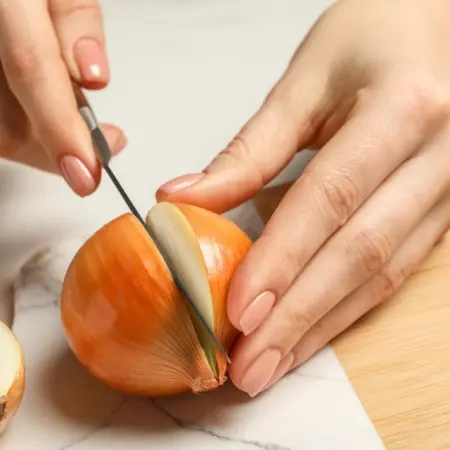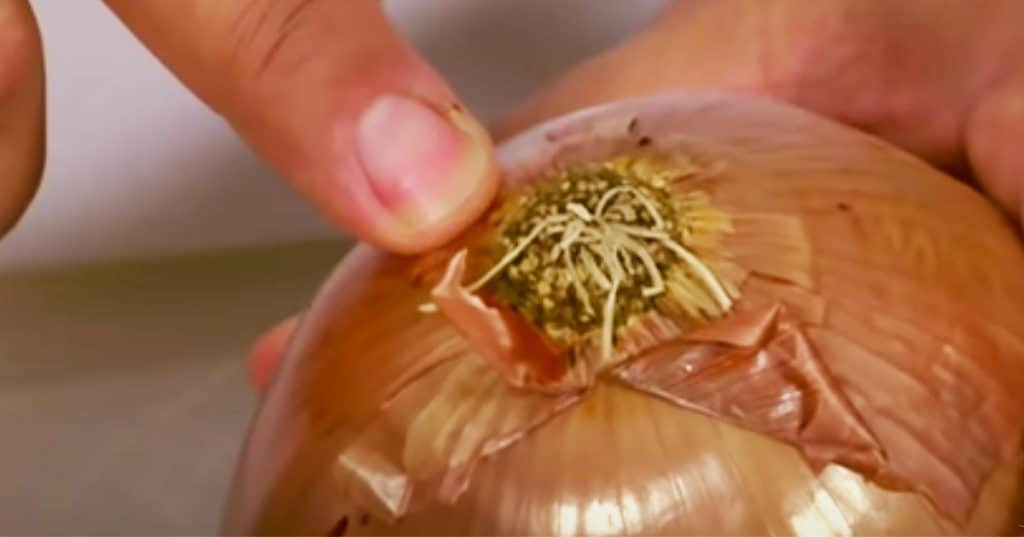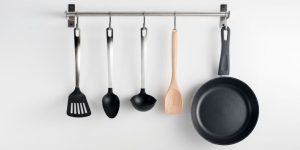Cutting an onion can quickly turn into a teary, frustrating experience. You start chopping, and before you know it, your eyes burn and water uncontrollably.
But what if you could slice through onions without shedding a single tear? Imagine preparing your meals with ease, no irritation, no mess, just smooth, tear-free chopping. You’ll discover simple, effective tricks that anyone can use to cut an onion without crying.
Say goodbye to watery eyes and hello to stress-free cooking! Keep reading to unlock these easy tips that will change the way you handle onions forever.

Credit: evidencenetwork.ca
Why Onions Make You Cry
Ever wondered why chopping onions turns your eyes into a water fountain? It’s not just about the smell or that strong taste. The real reason lies in a fascinating chemical reaction happening right on your cutting board.
The Chemistry Behind Tears
Onions contain sulfur compounds stored in their cells. When you cut into an onion, you break these cells open, releasing enzymes called alliinases. These enzymes react with the sulfur compounds to form a gas known as syn-Propanethial-S-oxide.
This gas is the real culprit that makes you tear up. It’s a volatile compound, meaning it quickly evaporates into the air and reaches your eyes. Your body then reacts by producing tears to flush out this irritant.
How Onion Vapors Affect Eyes
When syn-Propanethial-S-oxide gas reaches your eyes, it reacts with the water in your tear film. This creates a mild sulfuric acid, which irritates the nerve endings on your eyes’ surface. The irritation signals your brain to trigger tears as a defense mechanism.
You might notice some onions cause more tears than others. This happens because different onions have varying levels of sulfur compounds. Yellow onions, for example, often release more of this gas than sweet onions.
Have you ever tried cutting onions underwater or chilling them first? These techniques work because they slow down or trap the gas, reducing the chance it reaches your eyes. Understanding this can help you find practical ways to cut onions without the tears.
Preparation Tips To Reduce Tears
Onions often bring tears to our eyes while cooking. But with a few simple preparation tips, you can reduce those tears. Let’s explore some effective methods to keep your eyes dry while chopping onions.
Chill Onions Before Cutting
Cold temperatures slow down the release of onion fumes. Place onions in the fridge for about 30 minutes before cutting. This simple step can make a big difference in your cooking experience. Chilled onions are less likely to irritate your eyes.
Use A Sharp Knife
A sharp knife cuts onions cleanly, reducing cell damage. Less damage means fewer eye-irritating chemicals are released. Always keep your knife sharp for a smoother chopping experience. It also enhances your cutting efficiency, saving you time.
Cut Near An Open Flame
An open flame draws the onion fumes away from your eyes. Light a candle or use a gas stove while cutting. This method helps in dispersing the gases that cause tears. It’s a practical trick to keep your vision clear.
Effective Cutting Techniques
Mastering how to cut an onion without crying can transform your kitchen experience. Effective cutting techniques reduce the release of the irritating compounds that make your eyes water. These methods not only keep tears at bay but also improve your efficiency and safety while chopping.
Slice Underwater
Cutting an onion underwater limits the gas that escapes into the air and reaches your eyes. Fill a large bowl or your sink with cold water and slice the onion submerged. The water traps most of the irritating sulfur compounds, stopping them from making you tear up.
Just be careful to keep your knife sharp and your grip steady, as wet onions can be slippery. Have you tried this approach and noticed less eye irritation? It’s a simple trick that might surprise you with how well it works.
Cut Off The Root Last
The root end of an onion contains the highest concentration of sulfur compounds. Leaving the root intact until the very end minimizes the release of these tear-inducing chemicals. Start by slicing off the top and peeling the layers before tackling the root last.
This small change in your chopping order can significantly reduce tears. It’s a quick adjustment that doesn’t require special tools, just a bit of patience.
Use A Food Processor
Using a food processor keeps the onion’s strong fumes away from your eyes by containing the chopping process inside a sealed container. This method saves time and spares you from the uncomfortable eye irritation. Simply peel the onion, cut it into chunks, and pulse it in the processor until you reach your desired size.
Have you noticed how much easier prep work becomes with a food processor? It’s a handy tool that keeps your hands odor-free too.

Credit: us.kiwilimon.com
Home Remedies To Prevent Tears
Cutting onions often leads to watery eyes and discomfort. Home remedies can help reduce the tears and make cooking easier. These simple tricks use common items found at home and protect your eyes from the onion’s sting.
Wear Goggles
Wearing goggles creates a seal around your eyes. This stops onion fumes from reaching them. Choose snug-fitting goggles for the best effect. Swimming goggles work well as they keep air out completely. Clear vision remains while your eyes stay dry and comfortable.
Chew Gum While Cutting
Chewing gum distracts your brain from eye irritation. It also encourages breathing through the mouth. This reduces the amount of onion gases that reach your eyes. Choose mint or fruity flavors to keep your mouth fresh. This simple step helps lower tears significantly.
Apply Petroleum Jelly Around Eyes
Applying a thin layer of petroleum jelly on the skin around your eyes helps. The jelly acts as a barrier that blocks onion vapors. Use a clean finger to spread it carefully on your eyelids and under eyes. This method reduces irritation and keeps your eyes calm.
Kitchen Gadgets That Help
Cutting onions without shedding tears feels like a kitchen superpower. Luckily, some clever gadgets can make this challenge much easier. These tools reduce the onion’s irritating compounds before they hit your eyes, letting you chop away comfortably.
Onion Choppers
Onion choppers are designed to dice onions quickly and safely. They keep your hands away from the fumes that cause crying. Some models even come with a sealed lid, trapping the onion’s vapors inside.
I once used a basic onion chopper and noticed a huge difference—I could prepare salsa without watering eyes. Plus, these gadgets speed up prep time and create uniform pieces, which is great for consistent cooking.
Ventilated Cutting Boards
Ventilated cutting boards have small holes or slits that let onion gases escape. This reduces the buildup of tear-inducing compounds near your face. The idea is simple but effective: better airflow means less irritation.
Using one of these boards felt like a small kitchen hack that made a big impact. You might wonder if adding a fan nearby could help even more. It’s worth trying if you want a tear-free chopping zone.
Specialized Onion Glasses
Onion glasses are specially shaped eyewear that blocks the onion’s fumes from reaching your eyes. They fit snugly and prevent tears by creating a barrier between your eyes and the onion. Unlike regular glasses, they seal the area around your eyes.
I remember trying onion glasses at a friend’s house and was surprised how well they worked. They look unusual but can be a game changer if you chop onions often. Would you give them a try to save your eyes and time?
Quick Tips To Soothe Watery Eyes
Watery eyes can turn a simple kitchen task into an uncomfortable experience. Luckily, you don’t have to suffer through tears every time you cut an onion. These quick tips will help soothe your eyes fast and keep you focused on your cooking.
Rinse Eyes With Cold Water
If your eyes start to sting, gently splash them with cold water. The cool temperature helps reduce irritation and flushes away the onion’s sulfur compounds. You can even hold a cold, damp cloth over your eyes for a few moments to calm the burning sensation.
Blink Frequently
Blinking more often spreads your natural tears across your eyes, washing away irritants. Try to avoid staring too long at the onion, as that allows more tear-inducing compounds to build up. Keeping your eyes moving and blinking can make a surprising difference.
Use Eye Drops
Over-the-counter lubricating eye drops can provide quick relief. They add moisture and help flush out any lingering irritants. Keep a small bottle handy in your kitchen for moments when your eyes feel dry or irritated during cooking.

Credit: diyjoy.com
Frequently Asked Questions
How Can I Cut Onions Without Crying?
To cut onions without crying, chill them before cutting. Use a sharp knife and cut near running water or a fan to disperse the onion’s fumes.
Why Do Onions Make My Eyes Water?
Onions release sulfur compounds when cut. These compounds irritate your eyes, causing tears to flush out the irritants.
Does Using A Sharp Knife Help Reduce Tears?
Yes, a sharp knife causes less cell damage. This means fewer sulfur compounds are released, reducing eye irritation and tears.
Can I Prevent Tears By Cutting Onions Underwater?
Cutting onions underwater can reduce fumes reaching your eyes. However, it’s less practical and may affect your grip and cutting precision.
Conclusion
Cutting onions without crying is easier than you think. Small tips can make a big difference. Use a sharp knife to reduce onion damage. Chill onions before cutting to slow tear-causing chemicals. Work near running water or a fan to blow away gases.
These simple tricks help keep your eyes dry and pain-free. Practice them, and cooking becomes more comfortable. Enjoy cooking without the sting of tears. Try these easy steps next time you chop onions. Your eyes will thank you.

Hi, I’m Daniel Brooks—a food lover and kitchen gear enthusiast. I enjoy testing cookware, utensils, and gadgets to see what really works in everyday cooking. At PlugChef.com, I share honest reviews, comparisons, and simple guides to help you choose the best tools for a safer, smarter, and more enjoyable kitchen.











